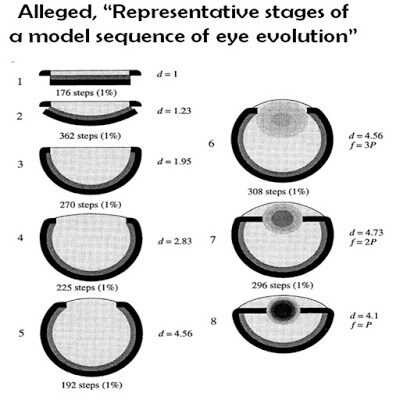What is interesting about the claim that the eye has evolved some 40 independent times is that the “evidence” is examples of such eyes that are fully functional. The “evidence” is not that they are changing into anything but that they are fully formed and doing just fine, thank you very much.
Well, interesting paper titled, “A pessimistic estimate of the time required for an eye to evolve,” was authored by Dan-E. Nilsson (Department ef Zoology, Lund University, Helgonaviigen 3, S-223 62 Lund, Sweden) and Susanne Pelger (Department ef Genetics, Lund University, Stilvegatan 29, S-223 62 Lund, Sweden); Proc. R. Soc. Lond. B 1994 AD 256, 53-58.
Here is the abstract:
Theoretical considerations of eye design allow us to find routes along which the optical structures of eyes may have evolved. If selection constantly favours an increase in the amount of detectable spatial information, a light-sensitive patch will gradually turn into a focused lens eye through continuous small improvements of design.
An upper limit for the number of generations required for the complete transformation can be calculated with a minimum of assumptions. Even with a consistently pessimistic approach the time required becomes amazingly short: only a few hundred thousand years.
They note:
The development of a lens with a mathematically ideal distribution of refractive index may at first glance seem miraculous.
But, of course, they, for some odd reason, seek to do away with such superstitious nonsense within the pages of a science journal—the Proceedings of the Royal Society B: Biological Sciences.
They point out:
Taking a patch of pigmented light-sensitive epithelium as the starting point, we avoid the more inaccessible problem of photoreceptor cell evolution.
Well, that’s so special. And with a wipe of their forehead, they can get right into pessimistically estimating the time required for an eye to evolve by beginning with something that is already in existence and not by having to answer why there is something, anything at all such as a patch of pigmented light-sensitive epithelium, rather than nothing.
Thus, they bypass bothersome issue such as how anything exists at all much less how we end up beginning with a patch of pigmented light-sensitive epithelium and jump right into it:
We have made such calculations by outlining a plausible sequence of alterations leading from a light sensitive spot all the way to a fully developed lens eye.
Although, it would seem that when estimating the time required for an eye to evolve one would actually have to include, you know, all that time that it took to get from nothing to a patch of pigmented light-sensitive epithelium and then add the time it took it to evolve into an eye but hey, I’m not scientists and must not understand such depths of knowledge.
The authors were very kind to evolution from nothing indeed as they note:
We let the evolutionary sequence start with a patch oflight-sensitive cells.
Good thing that they “let” evolution start that way, or else evolution would be in real trouble.
Also,
The nervous tissue in the vertebrate retina can also be ignored as this is clearly a part of the nervous system which just happens to reside in the eye.
When making peer reviewed estimations it is, apparently, always good to simply ignore, you know, facts and stuff, that would make guessing at things more difficult…or, something.
Here are some interesting, key, passages:
plausible values had to be assumed
Assuming constant intensity, the upper curve is thus for an eye which is 100 times larger than that for the lower curve.
We assume that the patch is circular, and that selection does not alter the total width of the structure. The latter assumption is necessary to isolate the design changes from general alterations of the size of the organ.
we assume that the retinal receptive field
the retinal sampling density is assumed always to match the resolution of the optical image
The spherical lens is assumed to fill the aperture
the refractive index is assumed to follow a smooth gradient
The refractive index of the vitreous body is assumed
we have assumed that the receptor diameter is continuously modified such that the photon catch per receptor
assuming that values above
we deliberately ignored this and assumed
Assuming that selection operates on small but random phenotypic variations, no distribution of refractive index is inaccessible to selection.
Throughout the calculations we have used pessimistic assumptions and conservative estimates for the underlying parameters. Should one or perhaps even two of these assumptions or estimates in fact be optimistic, we can trust that the remaining ones will at least compensate for the errors made.
we assume a generation time of one year
And that, ladies and gentlemen, is science, so called that is.
~~~~~~~~~~~~~~~~~~~~~~~~
A plea: I have to pay for server usage and have made all content on this website free and always will. I support my family on one income and do research, writing, videos, etc. as a hobby. If you can even spare $1.00 as a donation, please do so: it may not seem like much but if each person reading this would do so, even every now and then, it would add up and really, really help. Here is my donate/paypal page.
Due to robo-spaming, I had to close the comment sections. However, you can comment on my Facebook page and/or on my Google+ page.

